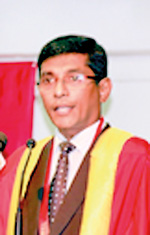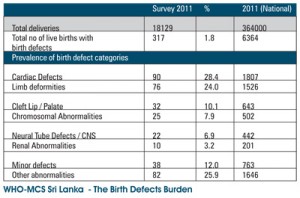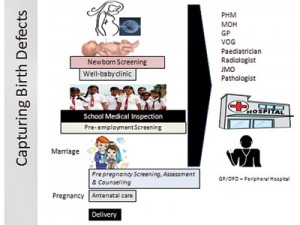Coping as a country with birth defects

Dr. Kapila Jayaratne
Nature is neither divine nor perfect. From time to time its creations are flawed. Such defects have aroused curiosity throughout human history. The earliest methodical recordings of birth defects (BDs) were made by the astrologers of ancient Babylon who wrote about the birth of monsters. Subsequent reports of historical evidence of birth defects are found from as far afield as Peru, Mexico, Italy, Greece, Egypt, Sri Lanka and Australia. A statue of conjoined twins, the Goddess of Anatolia, dating back to 6500 BC, found in southern Turkey, suggests that such defects of creation may even have been considered with awe and reverence.
The first historical evidence of cleft lip was found in a mummified Egyptian 2400- 1300 BC. Diagnostic imaging of King Tut’s mummy suggests that the pharaoh may have had a slightly cleft palate. Ancient Peruvian pottery also show drawings suggestive of harelip and congenital amputation of the arm.
Closer to home, Godakumbura hypothesises that the achondroplastic dwarfs carved into the guard stones seen among the ruins of ancient cities in Sri Lanka that date back to the 4th century AD probably represent people with birth defects. It is estimated that 7.9 million babies are born each year with a birth defect. Every year 6 million children die. Nearly 8% of child deaths (495,300) are attributed to birth defects.
The GBD study carried out in 2013, reports that approximately 246,600 newborns die annually during the first 28 days of life due to BDs and that this was the 4th leading cause of death in the neonatal period. The study also showed that when all ages are considered, BDs claimed 510,443 lives.
Prevention and control
The quantity and quality of services needed to be provided for dealing with BDs poses a major challenge to the health system of the country, considering the ever-increasing demand and diversity of care that is needed. Fetal anomaly scan | |
It is to be expected that as overall infant mortality rates decrease, the proportionate contribution of birth defects to infant mortality would increase. The country level infant mortality rates and deaths due to BDs in The March of Dimes Global Report on Birth Defects shows this.
In our region, in the SEARO countries, three conditions, birth defects, preterm birth/IUGR and birth asphyxia, account for 25% to 55% of under-5 mortality. Nearly 3.2 million BD-related disabilities are estimated every year. Birth defects assume 10th in the top 50 causes of global years of life lost in the year 2013 (GBD).
 What is a birth defect?
What is a birth defect?
BD is a structural or functional anomaly of organs, systems, or parts of the body that occurs during intrauterine life, and is caused by genetic or environmental factors or both, evident before birth, at birth or later in life. i.e. any abnormality affecting body structure or function that is present from birth.
Structural BDs are malformation, deformation, disruption and dysplasia. Some of the structural changes have significant medical, social or cosmetic consequences for the affected individual, and typically require medical intervention. The majority of defects seen are minor structural changes that pose no significant health problem in the neonatal period and tend to have limited social or cosmetic consequences for the affected individual.
Functional birth defects are Developmental disabilities, Metabolic diseases or Hematologic diseases. In 2010, the World Health Assembly, resolved to identify actions to address birth defects as an important cause of stillbirths and neonatal mortality. The resolution highlighted the need to raise awareness about the importance of BDs as a cause of child morbidity and mortality, set priorities, commit resources and develop plans for integrating effective interventions.
However, quality data on BDs is a global challenge. Most often valid data on the prevalence and correlates of BDs are not readily available at country or at regional levels posing challenges to preventive efforts. The March of Dimes Global Report on Birth Defects in 2006, described the systematic underestimation of the toll of birth defects in many countries.
It is in this scenario of paucity of data that we attempted to compile a Global Picture on birth defects analyzing the data from the recent WHO Multi-country Survey on Maternal and Newborn Health. This study was conducted in 359 health facilities from 29 countries in Africa, Asia, Latin America and the Middle East from 2010 – 2011.
The study identified cardiac malformations as the commonest reported group of malformations worldwide followed by limb abnormalities and minor abnormalities.
 WHO Multi-country survey on Maternal & Newborn Health
WHO Multi-country survey on Maternal & Newborn Health
(WHO – MCS)
During July – October 2011 we conducted the Sri Lankan component of the WHO Multi-country survey on Maternal & Newborn Health (WHO – MCS). The survey was implemented in a selected network of health facilities (n=14) in the Western, Southern and Eastern provinces.
Of the 18,129 women recruited 17,988 live births were reported. Among 317 live births with BDs, total of 369 defects were reported giving an “at birth prevalence” of BDs 1.8% (17.6 per 1000 live births).
When the findings are extrapolated for 2011 reported live births, it is estimated that a total number of 6400 are born with a birth defect in a year. Of these 1800 would have heart defects, 1526 limb deformities and 643 cleft lip or palate.
Similar to the findings from the worldwide data, in our country too, the commonest category of BDs found were cardiac malformations (27.7%) followed by limb abnormalities (23.6%) and cleft lip and palate (11.6%).
Causality of Birth Defects
BDs may be of genetic, environmental or complex in origin. Several environmental, nutritional, genetic, familial and maternal factors either alone or in combination cause BDs. However few studies provide an international perspective on risk factors or correlates of BDs. Socioeconomic inequalities also play a role in the occurrence of BDs.
In the WHO-multi-country survey – Older maternal age, multi-parity, higher educational attainment, maternal infections and maternal renal and hepatic diseases were associated with a higher proportion of reported BDs. Mothers aged more than 35 years, maternal infections, maternal renal diseases and male sex were significantly associated with BDs.
Analysis of factors/characteristics of women having newborns with BDs in the Sri Lanka component of WHO- multi-country survey found women aged more than 35 years who had given birth to a higher number of children, had an increased risk of BDs compared to women aged 20-35 years, the reference group.
This is an important implication considering that nearly 15.5% of all live births occurring in the country are to women over 35 years of age. Multiple pregnancy and male sex had higher risks of BDs.
Impact of Birth Defects
Availability of essential interventions needed to prevent neonatal deaths is crucial in a perspective of “Looking beyond child survival”. Both the WHO- multicountry survey global and Sri Lanka data showed that newborns with BDs had higher incidence of neonatal complications and increased risk for morbidity including LBW, preterm delivery, and admission to intensive care units compared to those without BDs.
They required a significantly higher amount of intervention procedures (Nasal CPAP), medications (anticonvulsants, phototherapy, blood products, steroids and intravenous antibiotic medication) compared to other newborns and also were at a higher risk for surgical interventions.
Surveillance
Surveillance involves data for action. Availability of quality birth defects data, utilizing such data effectively at different levels and dissemination to all stakeholders, facilitate effective birth defects prevention and control.
Age at diagnosis is a critical component of case identification. Typically, the higher the cut-off age, the greater the reported frequency of conditions, especially for conditions involving internal organs that may not be evident at birth. Nearly 60% of all major BDs are diagnosed during the first week of life, nearly 70% by the first month, nearly 90% by the first year, and almost 100% by the sixth year. Continuous alertness during the course of life is crucial in picking up birth defects.
There are many opportunities for the capture of birth defects at different points of the life course within the health care structure in Sri Lanka. (see graphic)Different service providers such as PHM, field well baby clinics, hospital clinics, Out Patient Departments, General practitioners, and Paediatricians, Laboratory and post-mortem reporting systems also can provide important information on this aspect.
Antenatal care coverage and institutional deliveries are very high in the country with reported 99.9% hospital deliveries, a majority in specialized units. Currently neonatal examinations (covering 100% of newborns) are carried out in all institutional births in the country based on a standardised format. Deaths during the perinatal period are subjected to institutional audits with a coverage of 98%. All these provide opportunities to detect birth defects.
The detection of BDs can be extended to the field situation. The post partum care coverage is around 73% and infants are followed up in the field until they are 5 years old. Any infant death that occurs is investigated by the area field team and is reported through a quarterly return to the national level.
In addition, there are disease-specific surveillance mechanisms such as the Thalassaemia Project and congenital rubella surveillance system. Although many countries in the region have no systematic birth defects surveillance (BDS) mechanism, Sri Lanka has taken several steps in initiating this.
Birth defects surveillance was implemented in the Southern Province on a pilot basis with the objective of scaling up to country-wide surveillance in the coming years. Data are collected on to a web-based database maintained by the Family Health Bureau.
Preliminary data over one year has reported 419 cases up to 2 years. Leading causes were cardiac defects, Chromosomal Disorders, cleft lip/ palate and gastro-intestinal defects with female predominance. Of the cardiac diseases the majority were Atrial septal defects and patent ductus arterioses. Many mothers were in the 20-35 year age group and a significant proportion (28 %) are above 35 years.
Burden
Giving birth to a baby with a BD is devastating to parents. It may result in long-term disability and have a major psychosocial impact not only on the individual but on all family members. The effects are felt beyond the family. They pose a burden to society and to the healthcare system.
( The above are extracts from the Dr. A. V. K. V. De Silva Oration – 2015 delivered to the College of Community Physicians of Sri Lanka)


